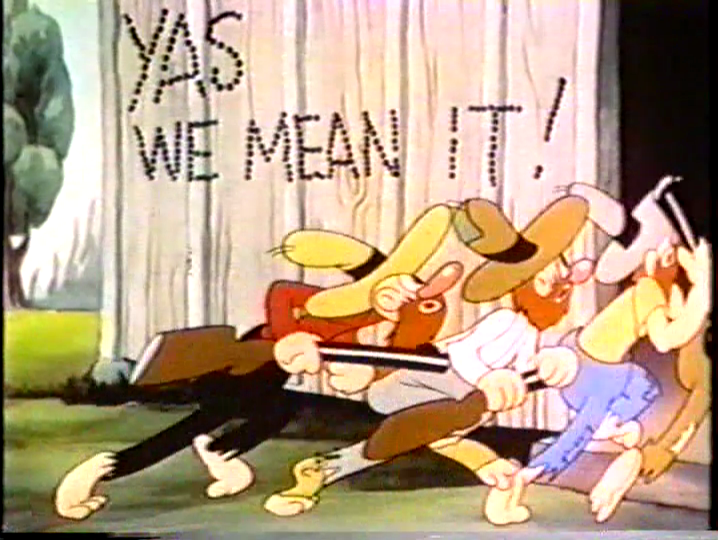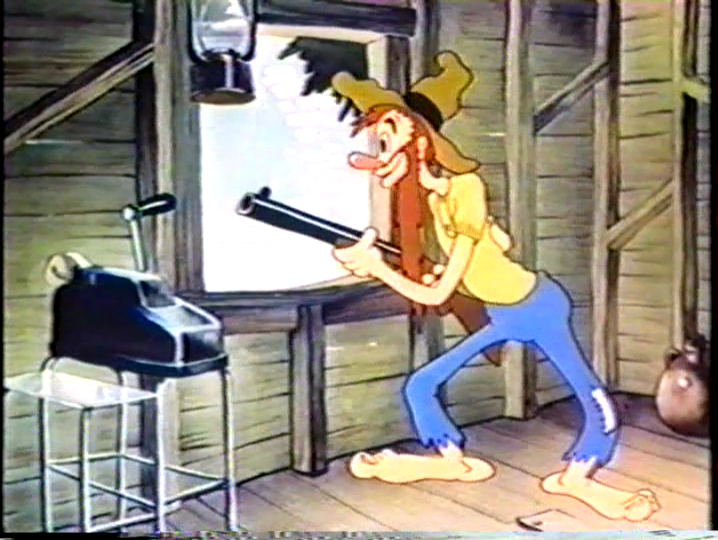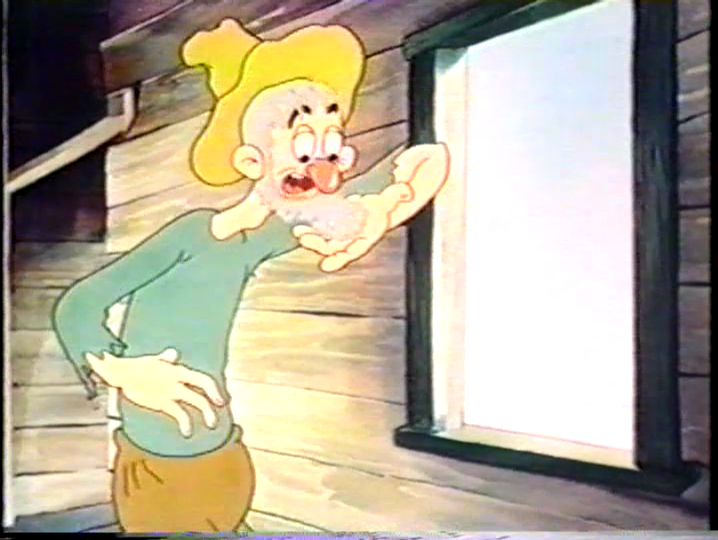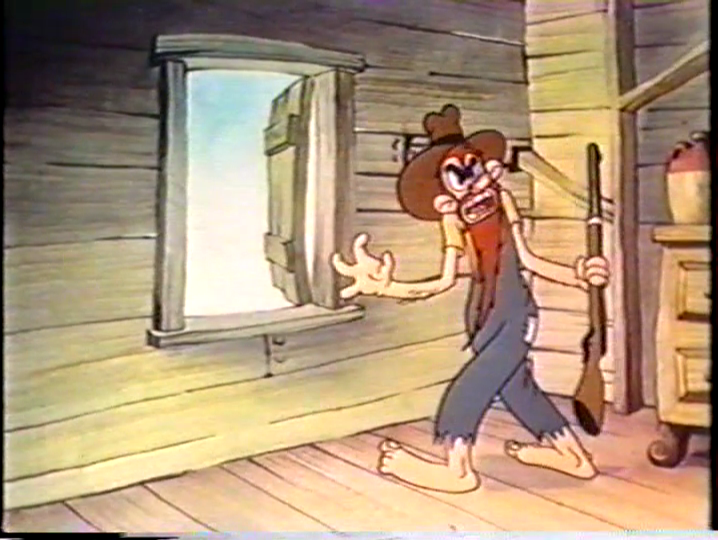DVD-Blu-Ray Availability: none
You may view this cartoon HERE.
Another sharp, smart and forward-reaching cartoon from the Fred Avery unit, A Feud There Was stresses speed, wit and barrier-breaking. On the heels of the superb Cinderella Meets Fella, this accentuates the positive in Avery's formal, rooted in past and future sensibility.
By this time, Avery knows how to follow the rules in order to best thwart and maim them. The immediacy he and his staff achieve makes this 77-year old cartoon still fresh and relevant.
In Avery's world, a bucolic scene is an invitation to vandalism. To the yodeling strains of the legendary Western singing group The Sons of the Pioneers, a long multiplane pan introduces us to the seemingly tranquil world of the Ozark mountains. No inter-titles are needed; the scene sets itself up through music and visuals.
Zoom in on mountaineer home. All is calm, all is bright...
To the tune of "Arkansas Traveler," that classic signifier of all things rural and backwards, we meet the Weaver clan, doing what nature intended of them:
File this under "Snoring, Funny." We truck up to a cuckoo clock.
Cuckoo struggles to emerge; is voiced by easily-recognizable Mel Blanc.
Bird deems "that horrible snorin'" to be "worse than a hurricane."
He adds, in high-falutin' voice, "from the motion picture of the same name."
This would be the John Ford-directed 1937 Oscar winner:
This movie is in no way parodied, or otherwise alluded to, in Avery's cartoon. It's an easy way to break down that fourth wall and get the audience accustomed to this state of mind.
Cuckoo produces sure fire waker-upper.
Mission accomplished.
Covers thrown back, a zoo's worth of Avery-designed
barnyard animals emerge to greet the day.
barnyard animals emerge to greet the day.
This is an ideal spot for a gag trilogy, and Avery wastes no time
achieving that goal.
achieving that goal.
A diagonal wipe takes us to another proto-Jacques Tati bit,
where a mundane item reveals a second, pracital use:
where a mundane item reveals a second, pracital use:
Tati's gag sense often comes so close to Avery's that I wonder if
the former was a fan of the latter. I don't believe he ever acknowledged
the influence of animated cartoons on his live-action work,
which is as cartoony as Frank Tashlin's.
Next, an Avery favorite: the truck-back "reveal" gag.
A clever comedic metaphor: "sawing wood."
Irv Spence handles this backwoods take on the
theories of Sir Isaac Newton:
(eons later...)
"Ouch."
Bonus inertia gag--again animated by Spence, with
one of the scraggliest felines in cartoon history.
"Bow wow."
Hiss...
Next is the fastest-paced, most-out-of-left-field gag we'll see
today, featuring the terrific combo of Sons of the Pioneers (with
hot violin by Hugh Farr) and Irv Spence animation.
The omniscient lowering of a KFWB mike brings
these Ozark sluggards to their feet.
these Ozark sluggards to their feet.
Their novelty ditty is punctuated with unison rifle blasts.
Killer posing throughout this sequence.
Then we have the cartoons' first commerical interruption.
I shan't spoil the impact of this startling, brilliant bit,
so watch the cartoon if you haven't already. This moment
begins at 2:30.)
I shan't spoil the impact of this startling, brilliant bit,
so watch the cartoon if you haven't already. This moment
begins at 2:30.)
Announcer exits stage left and the song continues.
Avery tosses in another truck out/reveal bit.
The inciting incident now occurs, courtesy a gravel-
voiced Weaver imp, who walks up the inside
of a chimney and hurls epithets at the McCoy clan.
This sullying of the McCoy name rouses lazy bones to action.
Their response literally spells out the offense taken.
A Weaver buckshot telegram reply.
Let the feudin', fussin' an' fightin' begin!
Avery is in a phase of gags that blend old-school
and modern technology. Here, a 1930s adding
machine helps this hill william keep score:
Next is an image that presages several visuals from
Avery's first-released M-G-M cartoon, The Blitz Wolf:
(sample Blitz Wolf image)
Warfare still accommodates gags, usually with
a morbid import, as here:
Throwaway bits that have nothing to do with the
body of the cartoon are in favor in Avery's 1938-1940
cartoons. Here's one of the more esoteric examples:
Said moment begins at 3:45. To transcribe it
would be wasted effort.
would be wasted effort.
What better time to introduce Elmerhead? (That's my name
for this interim mash-up of Egghead and Elmer Fudd.)
An iris introduces this soon-famous name to the world:
for this interim mash-up of Egghead and Elmer Fudd.)
An iris introduces this soon-famous name to the world:
Elmerhead's yodels, supplied by one of the Sons,
establish him as an otherworldly figure, much like
Avery's M-G-M non-hero, Droopy.
establish him as an otherworldly figure, much like
Avery's M-G-M non-hero, Droopy.
Via another technological gag, Avery delivers
his thesis of cartoon-making:
(sarcastically) Ha, ha.
"In one o' these here now cartoon pictures,
a body can git away with anything."
a body can git away with anything."
Words to live by.
Equally startling is this extreme fourth-wall buster:
(self-consciously): "The ole gray hair ain't what it usta be."
(laughs hysterically)
(realizes we're not amused; stops)
"Well, it sounded funny in rehearsal, anyway."
(fingers beard as if we might laugh, based on his soul-
baring confession)
This offhand statement adds a new layer to Avery's
self-aware characters. It's one thing to acknowledge
that you're a cartoon character, and that you know
you're being watched in the moment. It's another
to admit that you (and, presumably, others) have
rehearsed this material prior to performance.
Chuck Jones would make much of this conceit
in his celebrated 1950s cartoons. Let it be noted
that said conceit was born here.
Irv Spence takes the next gag...
Generic "Maw" makes aggression relieve her workload.
Do cartoon appliances mend after comical damage?
One wonders.
With a transitional piano flourish (a Carl Stalling identifier), we see a gag
Avery will return to throughout his career. This casual stance
toward the impossible is a defining part of Avery's comic vision.
(he spits in his hands)
In animal conflict, animals also suffer, as does this
sweet-natured mother hen.
Buckshot murders her unborn brood.
"Three days' work," hen wearily says...
"...shot to pieces."
She does that "whaddayagonnado" shrug.
Elmerhead putters into frame...
His knock is scarcely heard over the gunfire.
Nor is his entreaty for piece (piously voiced by Mel Blanc)
taken seriously by the feudants.
Another automation gag...
...leads to Avery's most daring use of the signature
silhouette-of-moviegoer business. Never before has
the interaction been so concrete and intense.
McCoy rants about his hatred of the Weavers.
"Is there a Weaver in the audience?" he shouts,
his shotgun pointed at us.
"Yeah, ya skonk!" a Weaver-in-silhouette replies.
He brought his rifle to the movies!
Buckshot transcends the shadow-world betwixt
viewer-reality and movie-reality...
...and it hurts!
McCoy looks vexed, humiliated.
Defenestrates self.
Loses hat, pride. Authorities fail to stop Weaver
from his act of cartoon terrorism.
Back to our conflict-in-progress.
Elmerhead's plea for peace to the other side...
...though beautifully animated by Irv Spence...
...results in another failure.
Genuinely funny sports metaphors are rare anywhere.
Here's the best example I know of...
Sheriff plays referee.
Declares red-bearded 'billy has fouled...
Via different animator, he is carried five yards down-field.
Now he can resume the slaughter.
This interior scene, as the one before it, features a nice
effect Avery and other units used in late 1930s Schlesinger
cartoons. The background animated figures' outlines
are in a neutral earth tone, to soften them and create
the illusion of depth. It's a touch most people wouldn't notice,
but it helps the effect of this and similar shots.
It's time for a showdown.
Elmerhead calls for a cease fire.
In superb character animation by our man Spence,
Elmerhead delivers an eloquent plea for pacifism.
Spence's follow-through, silhouettes and body language
are first-rate. Compare this to any Spence scene in a 1937 Avery
cartoon for proof of this animator's artistic growth.
While those early scenes are flashier, this is full of
high-level animation that supports the humor while
maintaining a viable character.
Mel Blanc uses one his earliest splatter-mouth effects
via the hillbilly with the grey hat.
This side not touched by peace plea.
Opposite side (by another animator trying hard to match
Spence's eccentric style) declines to choose serenity.
Hey, the red-bearded guy has a six-shooter!
Elmerhead is surrounded by his critics.
(en masse) "Now, what did you-all say?"
"I said we must have... peace."
Opposite of peace occurs.
Screen goes white with dust-cloud of violence.
Light again dawns...
...and Elmerhead has achieved peace.
Elmerhead yodels, with Karl Farr's rhythm guitar
in evidence.
"Good night, all..."
The Weaver is still watching!
"GOOD NIGHT!"
Again, buckshot breaches the distance between
viewer and viewed...
...and makes its point.
Just in time for the iris, Elmerhead looks back at us, stunned.
The end title from the cartoon's second re-issue, in September, 1952.
Its first re-run was in September, 1943.
toward the impossible is a defining part of Avery's comic vision.
(he spits in his hands)
In animal conflict, animals also suffer, as does this
sweet-natured mother hen.
Buckshot murders her unborn brood.
"Three days' work," hen wearily says...
"...shot to pieces."
She does that "whaddayagonnado" shrug.
Elmerhead putters into frame...
His knock is scarcely heard over the gunfire.
Nor is his entreaty for piece (piously voiced by Mel Blanc)
taken seriously by the feudants.
Assembled pan shot shows Elmer's fate.
Hillbillies laugh and slam door; return to war.Another automation gag...
...leads to Avery's most daring use of the signature
silhouette-of-moviegoer business. Never before has
the interaction been so concrete and intense.
McCoy rants about his hatred of the Weavers.
"Is there a Weaver in the audience?" he shouts,
his shotgun pointed at us.
"Yeah, ya skonk!" a Weaver-in-silhouette replies.
He brought his rifle to the movies!
Buckshot transcends the shadow-world betwixt
viewer-reality and movie-reality...
...and it hurts!
McCoy looks vexed, humiliated.
Defenestrates self.
Loses hat, pride. Authorities fail to stop Weaver
from his act of cartoon terrorism.
Back to our conflict-in-progress.
Elmerhead's plea for peace to the other side...
...though beautifully animated by Irv Spence...
...results in another failure.
Genuinely funny sports metaphors are rare anywhere.
Here's the best example I know of...
Sheriff plays referee.
Declares red-bearded 'billy has fouled...
Via different animator, he is carried five yards down-field.
Now he can resume the slaughter.
This interior scene, as the one before it, features a nice
effect Avery and other units used in late 1930s Schlesinger
cartoons. The background animated figures' outlines
are in a neutral earth tone, to soften them and create
the illusion of depth. It's a touch most people wouldn't notice,
but it helps the effect of this and similar shots.
It's time for a showdown.
Elmerhead calls for a cease fire.
In superb character animation by our man Spence,
Elmerhead delivers an eloquent plea for pacifism.
Spence's follow-through, silhouettes and body language
are first-rate. Compare this to any Spence scene in a 1937 Avery
cartoon for proof of this animator's artistic growth.
While those early scenes are flashier, this is full of
high-level animation that supports the humor while
maintaining a viable character.
Mel Blanc uses one his earliest splatter-mouth effects
via the hillbilly with the grey hat.
This side not touched by peace plea.
Opposite side (by another animator trying hard to match
Spence's eccentric style) declines to choose serenity.
Hey, the red-bearded guy has a six-shooter!
Elmerhead is surrounded by his critics.
(en masse) "Now, what did you-all say?"
"I said we must have... peace."
Opposite of peace occurs.
Screen goes white with dust-cloud of violence.
Light again dawns...
...and Elmerhead has achieved peace.
Elmerhead yodels, with Karl Farr's rhythm guitar
in evidence.
"Good night, all..."
The Weaver is still watching!
"GOOD NIGHT!"
Again, buckshot breaches the distance between
viewer and viewed...
...and makes its point.
Just in time for the iris, Elmerhead looks back at us, stunned.
The end title from the cartoon's second re-issue, in September, 1952.
Its first re-run was in September, 1943.
A Feud There Was is Fred Avery's most sophisticated and forward-reaching work to date. A growing confidence, noted in earlier posts, serves he and his unit well. As the gags get wilder, and their timing swifter, their firm base of a "yes, we can" attitude makes out-there ideas work 100%.
Avery's earlier endeavors to break the wall between audience and screen have often been brilliant, but marked by a timidity--a tacit worry that they might not work. Avery now knows that his audience can take it, and ramps up the surprises with each new cartoon. The last person on earth to brag about his skills, Avery had a right to be proud of this work. It's one thing to come up with an avant-garde idea. It's another level to get it past the suits, and out to a mainstream audience.
The great screen comedians--and Avery is on this top berth--had this knack. In other hands, this same assemblage of gags and scenes might completely fail (as do many of Avery's imitators, from this point on). To put such intellectually challenging material into a night at the movies, and have audiences enjoy it, was a great gift. Avery and his team have it in spades here, and will continue to dish it out for the next few years.
In its debut, the overall effect of A Feud There Was must have been overwhelming. The depth and intensity of its fourth-wall routines was something no one else had yet fully achieved. Avery was, of course, not the first cartoon-maker to acknowledge and exploit the relationship between viewer and viewed. Most of his best ideas have roots in silent live-action and animated films, radio humorists, and other mass-media outlets. His ability to synthesize this material, and make it seem fresh again, through a seemingly intuitive understanding of why it would be funny, and how it would affect the viewer, made the works of his Hollywood animation career possible.
NEXT: Elmerhead goes native in Johnny Smith and Poker-Huntas.
Avery's earlier endeavors to break the wall between audience and screen have often been brilliant, but marked by a timidity--a tacit worry that they might not work. Avery now knows that his audience can take it, and ramps up the surprises with each new cartoon. The last person on earth to brag about his skills, Avery had a right to be proud of this work. It's one thing to come up with an avant-garde idea. It's another level to get it past the suits, and out to a mainstream audience.
The great screen comedians--and Avery is on this top berth--had this knack. In other hands, this same assemblage of gags and scenes might completely fail (as do many of Avery's imitators, from this point on). To put such intellectually challenging material into a night at the movies, and have audiences enjoy it, was a great gift. Avery and his team have it in spades here, and will continue to dish it out for the next few years.
In its debut, the overall effect of A Feud There Was must have been overwhelming. The depth and intensity of its fourth-wall routines was something no one else had yet fully achieved. Avery was, of course, not the first cartoon-maker to acknowledge and exploit the relationship between viewer and viewed. Most of his best ideas have roots in silent live-action and animated films, radio humorists, and other mass-media outlets. His ability to synthesize this material, and make it seem fresh again, through a seemingly intuitive understanding of why it would be funny, and how it would affect the viewer, made the works of his Hollywood animation career possible.
NEXT: Elmerhead goes native in Johnny Smith and Poker-Huntas.














































































































































































































































I like the name that you chose, Elmerhead. This is one a few times that Blanc did Elmer/Eggy's voice (another Elmerhead short, the later "A Day at the Zoo" has him voiced by Blanc as a animal teasing Lou Costello impression, and the 1937 debut when it was just toupee wearing Egghead, had Blanc using his Daffy voice that he was still using at this particular time.SC
ReplyDeleteA bit late, but to explain the "Esoteric" gag--
ReplyDeleteThe voice in the cellar says "My name is Non-Stop Corrigan...I thought I was headed for Los Angeles! My compass broke!" That's, of course, a current-headline reference to "Wrong-Way Corrigan", who tried to break the NY-LA flying record in '38 and ended up across the Atlantic in Ireland. (Note the "Wearin' of the Green" musical sting at the end.)
https://www.dailymotion.com/video/x3hzblp - I'm sending the link for the so-called 1995 print, however with altered ending title card and ending music cue (since the 1995 EU dubbed tracks used to alter the ending music cue).
ReplyDelete